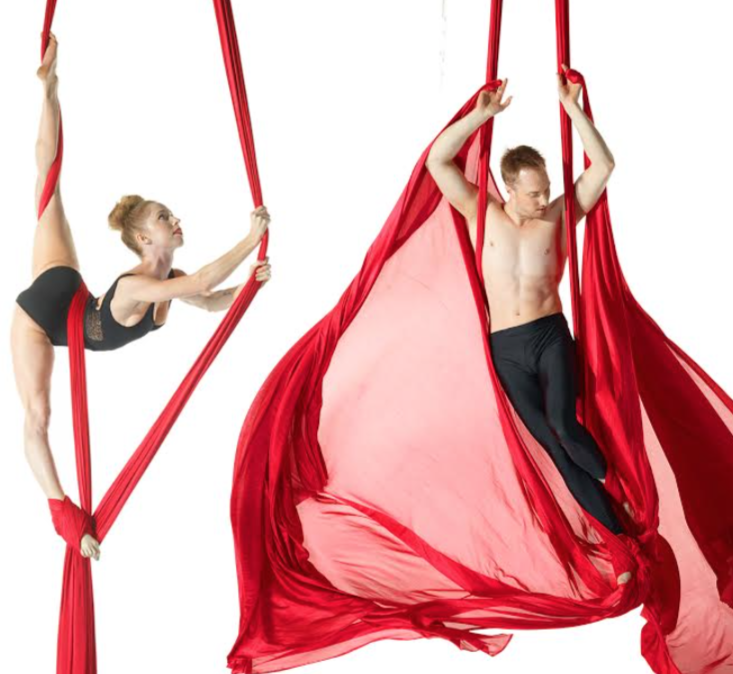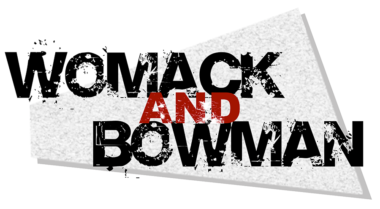A few months ago we were invited to perform our Duo Silks act as well as a Rope and Hammock solo at the opening of a swanky new hotel on the East Coast of the US. We were informed that the ballroom we were to perform in had low ceilings (around 16 feet), which was a challenge that we were reasonably familiar with and so we prepared accordingly.
When we arrived early in the morning on the day of the performance we were shocked to discover that the ceiling was even lower then we had anticipated (closer to 14 feet with the rigging truss) and our working performance height was a mere 13 feet!
After the initial panic and W&B dramatics;
“This is a disaster, we are going to look like amateurs! We can’t do this, can we?!”
The show director gave us an extra 30 minutes of stage time to re-work our acts (a generous amount of time considering she had 10 acts to stage and close to 20 performers to manage and rehearse) and we altered our choreography to suit the (very) low ceiling height.
While the remaining cast continued to rehearse on stage we spent the next 8 hours or so visually preparing our ‘new’ acts. We listened to the music, solidified new transitions that were to replace drops that were no longer possible, found moments of audience connection and ground partnering in place of our intricate doubles choreography on the Silks that required height.
Despite our nerves and fear of being ‘boring’ so low to the ground, the performance went beautifully. Perhaps it was our ‘Lets give EVERYTHING –we-have- so-they- forget-how-low-we-are’ attitude that helped win over the wonderfully generous audience, more likely however, it was those hours spent visually preparing for our ‘re-imagined’ performance. Would we have liked more time to physically rehearse? Sure, who wouldn’t? But in this particular case it was not possible, nor would it have done our forearms and shoulders any good to over-train on the day of an aerial performance.
Visualization has long been one of the primary technologies used in sports psychology. Although in this situation we were all but ‘forced’ into using visualization techniques to improve our performance, studies suggest that when practiced regularly, mental imagery can be a powerful tool for achieving your goals and improving performance, whatever your sport or in this case, art.
Whether you are preparing for an aerial performance or competition, you are recovering from an injury or simply unable to get to aerial class or open workout as often as you would like, having an understanding and a regular visualization practice will help you reach your aerial goals faster and enrich your training and performance experience.
Lets take a look at some of the techniques recommended by peak performance consultant Matt Neason, founder of PeakPerformance Sports and how they can be applied to our aerial practice.
– Practice Makes Perfect
If you struggle with visualization, then we have some comforting news for you. You’re normal. Sure there are some people who have the ability to close their eyes and instantly bring up crystal clear images, but for many of us this is a skill that needs to be developed over time. With practice however, everyone has the ability to visualize.
There are two keys principles to keep in mind when practicing visualization. The first is, your practice needs to be consistent. 10 minutes a day every day, will always beat an intense hour-long session once a week. It helps to make a commitment to practice your visualization the same time every day. First thing in the morning as close to waking as possible is ideal. This is because the mind is still slightly lucid at this time, which makes it easier to conjure up images.
The second key principle is you need to stay positive. Even if you can’t summon crystal clear images yet, you will still gain huge benefits from your visualization practice. It still works. Just connect to the image in whatever way you can. For some people that will be feeling the image, or just getting a sense of what it might look like. Wherever your current level is, nurture it and allow it to grow.
– Visualize What You Want (Perfect Wheeldowns? Straight-arm inverts? Over splits?)
One of the most powerful effects of good visualization is that it programs the subconscious brain. The problem with most people is that they program their subconscious mind with negative coordinates. They visualize images of failure, they replay mistakes, they think about negative scenarios that might happen, and picture the negative consequences that may arise. Unfortunately the subconscious mind doesn’t judge. It doesn’t say “those coordinates are negative so I’ll just ignore them”. In that way it’s very similar to the GPS system in your car (or phone). The GPS doesn’t judge, it simply takes you to the programmed destination. The theatre of your mind is the one place where you can ensure success. You can execute skills flawlessly, you can dominate your competition, and you can ensure victory. By visualizing success, you program your subconscious to move towards success.
– Shift Perspective
Let’s do a quick exercise. Relax and concentrate on your breath. As you continue to relax, bring up an image of you on your favorite aerial apparatus, competing or performing in front of a crowd. Where is this performance being held? Who are you competing against or performing with? See if you can involve all the senses. What do you see? What do you hear? What do you feel? Go a little deeper. What do you smell? Play around with this image of yourself. See yourself performing at your very best. Give yourself permission to dream, to push your current boundaries. Ok, so once you’ve done this and feel like you’ve really completely connected to this vision, read on.
When you saw yourself performing, what was the vision of yourself like? Was it as though you were watching yourself on a TV screen, essentially seeing your entire body as well as everything around you? Or was it more like you were looking out from your body, seeing things exactly as you would if you were there for real? Maybe you flicked between these two perspectives. These perspectives are referred to as being disassociated (the first one) and being associated (the second one). Generally people have a preference one-way or the other. Sometimes their preferences may change, depending on the goal of the visualization, which is actually a skill you want to develop.
It is commonly accepted that being associated in visualization (looking out from your body just as you would if you were really there) is the more powerful of the two perspectives. Being associated helps you connect to the feeling of the visualization, which as you’ll see shortly is critically important. However, being disassociated also has some really valuable uses. As an example, in gymnastics or diving, it can be useful for an athlete to disassociate from the visualization to better understand the nuances of how their body looks when they move. Other useful times to disassociate include working through a painful experience to gain wisdom from it, or in the initial stages of visualizing a performance that is completely outside your current reality. The key is, play around with being both associated and disassociated and find out what works best for you.
– Pump It Up
The visualization is important, but what’s even more important is the feeling it creates inside of you. A visualization without feeling is like a car without fuel. Feelings lead to emotions, and emotions are the fuel of your performance. Create powerful emotions, and you’ll create powerful performance states. Based on this, a huge key to visualization is pumping the experience, or in other words increasing the intensity of your emotions. There are a number of ways you can do this. One that we’ll focus on here is ‘painting with more color.’
Briefly go back to your earlier visualization. Was your visualization in color or in black and white? If it was color we want you to quickly rerun your visualization, but this time make the images black and white. Alternatively if it was originally in black and white, do the same as above but this time make the images full color. What did you notice? When you add color and brightness to your visualization, you add more energy to it. Your emotions intensify. You can play around with this experience. Make your images even more colorful. Make them even brighter. If you can, make them so bright that they glow. Learning to ‘paint with more color’ will dramatically increase the potency of your visualizations. This is a very simple, yet highly effective ways to pump your visualization.
– Matt Neason (with a few ‘aerial related tweaks’ by us!)
The Power of Visualization
This week, we challenge you to experiment with visualization as a training tool. Imagine that drop or trick that you want to master, picture yourself executing it effortlessly and then ‘pump’ the image with color and energy! Put your visualization into practice when you get to class or open workout, do you notice anything different?







